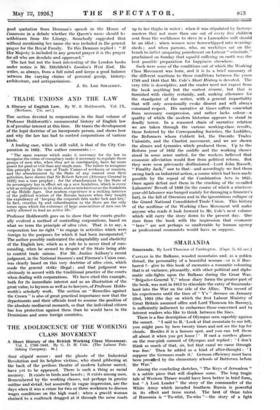THREE LONDON BOOKS - Good Company in Old Westminster and
the Temple. By Constance Hill. (Published by the Bodley Head. Price 15s.)
London's West End. By P. H. Ditchfield. (Published by Jonathan Cape, Ltd., London. 16s. Boston and New York : Houghton Mifflin Company.)
A Short History of the Tower of London, by the Keeper of the Jewel House, is " an abbreviated edition of a work on the same subject by the same author, which it is hoped will be ' of use to those who visit the Tower of London and wish to carry away some recollection of its significance in English ' history." That was an excellent intention, and it is well carried out.
The book, as might be supposed, gives a careful and detailed account of the jewels. Naturally one turns to the account of the Koh-i-Nur. I note that Sir George Younghusband does not tell the traditional story which he no doubt has heard orally and possibly rejected as ill-founded. All the same, it is . worth putting on record. The artillery officer who first obtained possession of the Koh-i-Nur on the occupation of Dhuleep Singh's palace kept it for safety in his pocket, not wishing to draw attention to the possession till he could get it deposited in safety with the Government at Calcutta. One day at mess he found that in changing into his dinner clothes he had left the Koh-i-Nur in his waistcoat in his bedroom. Instead, however, of leaving the table in search of his precious jewel, he merely beckoned his servant (waiting in the Indian • way behind his chair) and told him to bring the waistcoat. The man brought it ; the officer put his hand into the pocket, took out the jewel and placed it in the waistcoat he was wearing, and no one paid any attention to the transaction. If he had run out of the mess and made a " where-on-earth-is-it " scene he would have advertised the fact that the Koh-i-Nur was in his possession.
Miss Constance Hill's account of the good company that gathered in old Westminster and the Temple a hundred years ago has several good stories. The book, we are told, is founded on the early recollections of Anne Lefroy, whose father was John Rickman. The pictures are notable, whether of landscapes or of men. Nothing could be better than Leigh Hunt's half caricature, half sympathetic portrait, by Maelise. Very de- lightful also are the pictures of Westminster, and the Temple Stairs as they used to look a hundred or a hundred and fifty years ago.
. In the short chapter giving an account of the trial of George IV's wife, Queen Caroline of Brunswick, there is a good quotation from Denman's speech in the House of Commons in a debate whether the Queen's name should be withdrawn from the Liturgy. Somebody suggested that without mentioning her name she was included in the general prayer for the Royal Family. To this Denman replied : " If Her Majesty is included in any general prayer it is the prayer for.all who are desolate and oppressed."
The last but not the least interesting of the London books under notice is Mr. Ditchfield's London'i 'Vat End. He writes, as always, from a full mind and keeps a good balance between the varying claims of personal gossip, history. architecture, and antiquarianism.
J. ST. LOE STRACHEY.















































 Previous page
Previous page